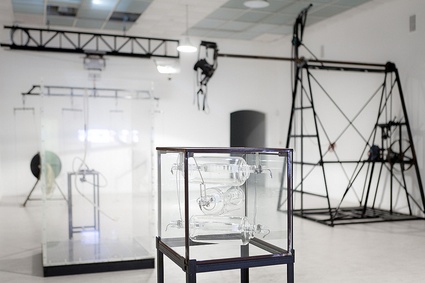 Kris Verdonck, Warehouse of machinery, used in performances / installations, 1995 – present. Part of EXHIBITION #1. Photo: Kristof Vrancken / Z33
Kris Verdonck, Warehouse of machinery, used in performances / installations, 1995 – present. Part of EXHIBITION #1. Photo: Kristof Vrancken / Z33
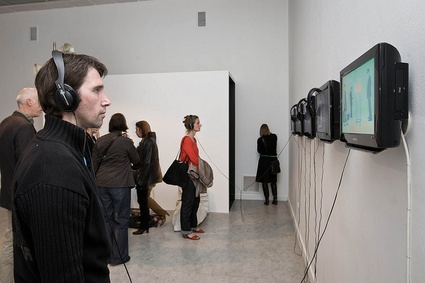 Kris Verdonck, Warehouse of machinery, used in performances / installations, 1995 – present. Part of EXHIBITION #1. Photo: Kristof Vrancken / Z33
Kris Verdonck, Warehouse of machinery, used in performances / installations, 1995 – present. Part of EXHIBITION #1. Photo: Kristof Vrancken / Z33
So far the work of Kris Verdonck was mostly a privilege reserved to the aficionados of theater stages but Z33 in Hasselt has invited the theatre-maker and artist to invade its rooms with wonderful machinery, installations, videos and even a metaphorical garden made of some of the most invasive non-native plant and animal species in Belgium. It’s the artist’s first ‘gallery’ exhibition. Hence the title of the show.
His works are incredibly invigorating because of their originality and poetry but a few moments spent in their company reveals their dark undertone.
The work of Kris Verdonck (…) focuses on the confusion of man in an estranged world due to technological development. The tension between man and machine, between living species and dead materials creates an atmosphere of Unheimlichkeit or eeriness. This ‘current state of the world’ – with its environmental problems, ecological disasters and wars – is the central theme through his oeuvre.
In the solo exhibition in Z33, Kris Verdonck focuses on the one hand on the confusion and eeriness of man in his environment. On the other hand, his work is about the confusion of the world itself in which the Apocalypse already took place.
EXHIBITION at #1 is a bold move, the challenge was to prove that Verdonck’s pieces, many of which the artist describes as “big installations that are displayed in a theatrical context”, were strong enough to stand on their own two feet in a contemporary art gallery. I had never experienced any of his works in theatres before so i had no preconceptions nor expectations. All i saw were absorbing videos, stunning installations and an earnest robot.
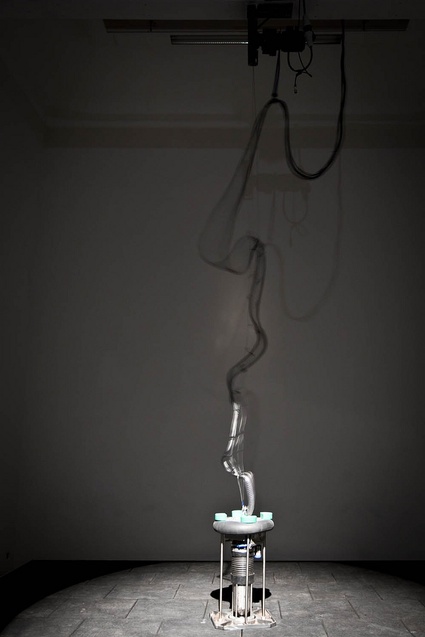 Kris Verdonck, DANCER #3, 2010. Produced for the performance ACTOR #1. Photo: Kristof Vrancken / Z33
Kris Verdonck, DANCER #3, 2010. Produced for the performance ACTOR #1. Photo: Kristof Vrancken / Z33
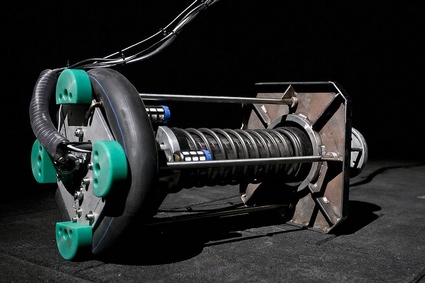 Kris Verdonck, DANCER #3, 2010. Produced for the performance ACTOR #1. Photo: Kristof Vrancken / Z33
Kris Verdonck, DANCER #3, 2010. Produced for the performance ACTOR #1. Photo: Kristof Vrancken / Z33
DANCER #3 is one node of ACTOR #1 which explores the metamorphosis from chaos to order. One of the starting points for this work was the history of the creation of the ‘homunculus‘, the artificial miniature human that philosophers, alchemists and scientists have sought over the centuries since Greek Antiquity.
DANCER #3 is a robot trying to stand up straight; he always falls down again, but never gives up. His energy and clumsiness display the optimism of a clown who’s always tripping over.
In Box, a glass cube contains the strongest possible light source that can be concentrated on such a small surface. As spectators –equipped with protective glasses– watch the light, they hear the voice of the actor Johan Leysen who speaks, in German, the apocalyptic texts by dramatist Heiner Müller: Verkommenes Ufer Medeamaterial Landschaft mit Argonauten (Despoiled Shore Medea Material Landscape with Argonauts) (1982-1983.)
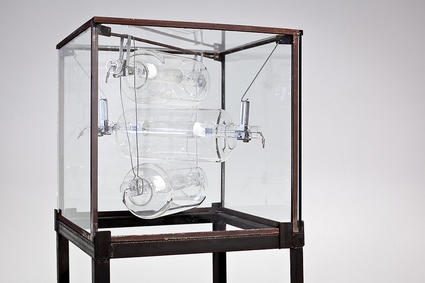 Kris Verdonck, BOX. Part of EXHIBITION #1. Photo: Kristof Vrancken / Z33
Kris Verdonck, BOX. Part of EXHIBITION #1. Photo: Kristof Vrancken / Z33
Light that normally allows us to see was made so strong by the team of engineers Verdonck collaborated with that it turns us blind. BOX is the second installation in a series of installations that examine “the end of the world” from different points of view. Its light could be the luminous flash of a nuclear explosion, a never ceasing, eye-burning lightning that announces the end of the world.
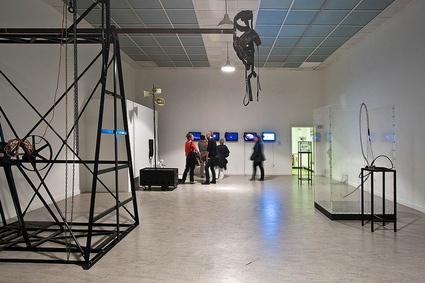 Kris Verdonck, Warehouse of machinery, used in performances / installations, 1995 – present. Part of EXHIBITION #1. Photo: Kristof Vrancken / Z33
Kris Verdonck, Warehouse of machinery, used in performances / installations, 1995 – present. Part of EXHIBITION #1. Photo: Kristof Vrancken / Z33
The most jaw-dropping moment for me was when entered a big room on the first floor of Z33 filled with the appliances and objects developed by the artist for live shows. Most of them would normally be kept behind the scenes. The machines often look like medieval instruments (of torture). At the same time, they are often high-technological objects, that fulfil complex functions. They form a large contrast with the extreme esthetical images that they produce.
The overview of machines by Kris Verdonck addresses the field of tension between man and machine in today’s society. What relationship can/must/do people want to enter into with technology? How difficult is the balancing act between human control and submission to machines?
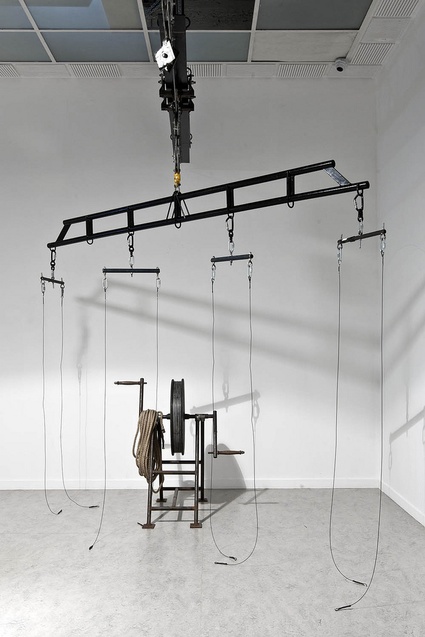 Kris Verdonck, Warehouse of machinery, used in performances / installations, 1995 – present. Part of EXHIBITION #1. Photo: Kristof Vrancken / Z33
Kris Verdonck, Warehouse of machinery, used in performances / installations, 1995 – present. Part of EXHIBITION #1. Photo: Kristof Vrancken / Z33
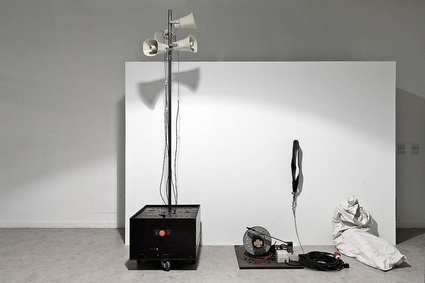 Kris Verdonck, Warehouse of machinery, used in performances / installations, 1995 – present. Part of EXHIBITION #1. Photo: Kristof Vrancken / Z33
Kris Verdonck, Warehouse of machinery, used in performances / installations, 1995 – present. Part of EXHIBITION #1. Photo: Kristof Vrancken / Z33
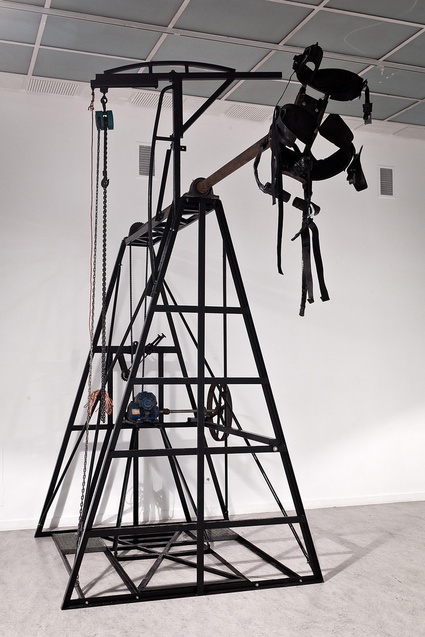 Kris Verdonck, Warehouse of machinery, used in performances / installations, 1995 – present. Part of EXHIBITION #1. Photo: Kristof Vrancken / Z33
Kris Verdonck, Warehouse of machinery, used in performances / installations, 1995 – present. Part of EXHIBITION #1. Photo: Kristof Vrancken / Z33
For the IN performance, an actress remains motionless for an hour in a transparent cube filled with water. The distortion to her senses caused by the environment she is in makes her go into a trance. The sounds of her breathing and movement are amplified by microphones.
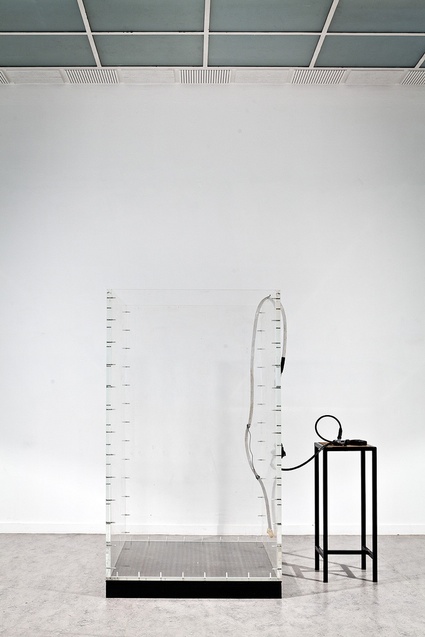 Kris Verdonck, Warehouse of machinery, used in performances / installations, 1995 – present. Part of EXHIBITION #1. Photo: Kristof Vrancken / Z33
Kris Verdonck, Warehouse of machinery, used in performances / installations, 1995 – present. Part of EXHIBITION #1. Photo: Kristof Vrancken / Z33
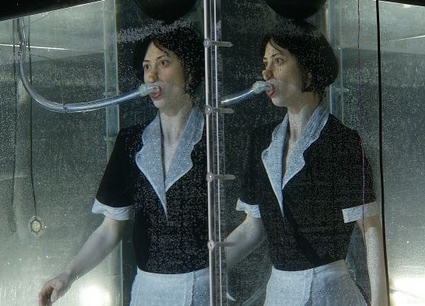 Kris Verdonck, IN (image from a performance found on the artist’s website)
Kris Verdonck, IN (image from a performance found on the artist’s website)
I wish i’d have time to talk about every single work i saw in the show but i’d better wrap up the asap and hit ‘publish’ before it’s too late for you to drive to Hasselt and see the show which closes on Sunday already so i’ll end with two of the most stunning video works:
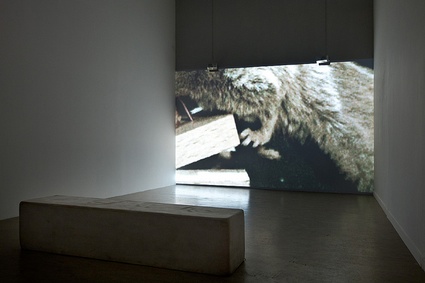 Kris Verdonck, MOUSE. Photo: Kristof Vrancken / Z33
Kris Verdonck, MOUSE. Photo: Kristof Vrancken / Z33
MOUSE shows – enormously magnified and in extreme slow-motion – a mouse walking into a trap. The trap closes, the iron breaks the small body. A camera with super slow motion (10,000 images/sec) was used to unravel the mechanics of a movement, just like Muybridge did. The technique makes us experience an extremely upsetting emergency situation in the slowest possible way.
We eat meat every day but we don’t want to be remembered that animals have to be killed before they land on our plates, and we definitely don’t want to be confronted with it visually. MOUSE is an image of our daily hypocrisy turned into a slow motion opera that fills a whole room.
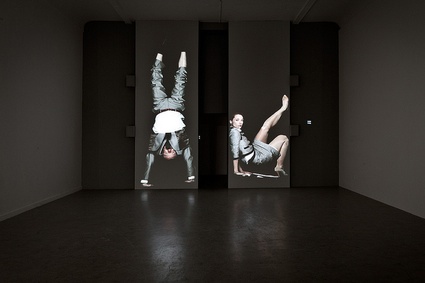 Kris Verdonck, FRIEZE, 2010. Produced for the ‘circuit performance’ K, a Society. Photo: Kristof Vrancken / Z33
Kris Verdonck, FRIEZE, 2010. Produced for the ‘circuit performance’ K, a Society. Photo: Kristof Vrancken / Z33
The figures in the large-scale projection FRIEZE look like your typical posh office workers. Neatly dressed, impassible and modern. After a few minutes however, their sharpness starts to crack. No matter how hard they try, the businessmen loose their decorum as their bodies slip, tumble and move awkwardly around the claustrophobic space they are confined to.
The characters in FRIEZE could be considered to be a modern version of the majestuous Greek caryatids. These sculpted female figure were functional as well as ornamental and emanated gravitas. The caryatids in FRIEZE on the other hand, display their vulnerability in the extreme.
The catalogue of the exhibition is available online.
Kris Verdonck – EXIBITION #1 closes this week at Z33 House for Contemporary Art in Hasselt, Belgium.
Previously: EXOTE, an indoor garden for invasive alien species.
